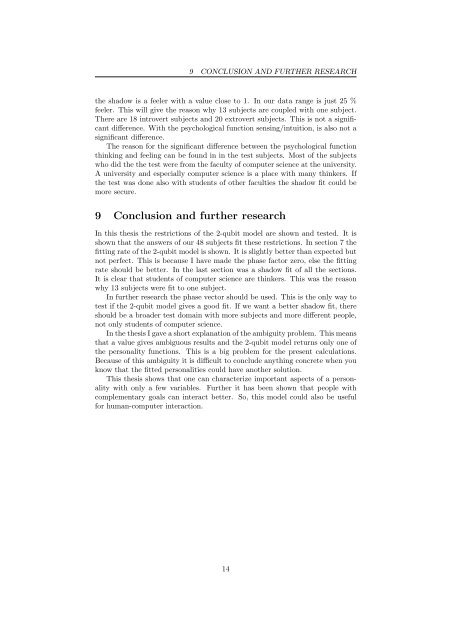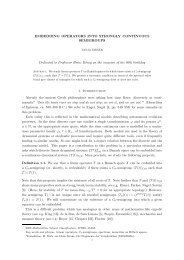Automatic modeling of personality types - Universiteit van Amsterdam
Automatic modeling of personality types - Universiteit van Amsterdam
Automatic modeling of personality types - Universiteit van Amsterdam
Create successful ePaper yourself
Turn your PDF publications into a flip-book with our unique Google optimized e-Paper software.
9 CONCLUSION AND FURTHER RESEARCH<br />
the shadow is a feeler with a value close to 1. In our data range is just 25 %<br />
feeler. This will give the reason why 13 subjects are coupled with one subject.<br />
There are 18 introvert subjects and 20 extrovert subjects. This is not a significant<br />
difference. With the psychological function sensing/intuition, is also not a<br />
significant difference.<br />
The reason for the significant difference between the psychological function<br />
thinking and feeling can be found in in the test subjects. Most <strong>of</strong> the subjects<br />
who did the the test were from the faculty <strong>of</strong> computer science at the university.<br />
A university and especially computer science is a place with many thinkers. If<br />
the test was done also with students <strong>of</strong> other faculties the shadow fit could be<br />
more secure.<br />
9 Conclusion and further research<br />
In this thesis the restrictions <strong>of</strong> the 2-qubit model are shown and tested. It is<br />
shown that the answers <strong>of</strong> our 48 subjects fit these restrictions. In section 7 the<br />
fitting rate <strong>of</strong> the 2-qubit model is shown. It is slightly better than expected but<br />
not perfect. This is because I have made the phase factor zero, else the fitting<br />
rate should be better. In the last section was a shadow fit <strong>of</strong> all the sections.<br />
It is clear that students <strong>of</strong> computer science are thinkers. This was the reason<br />
why 13 subjects were fit to one subject.<br />
In further research the phase vector should be used. This is the only way to<br />
test if the 2-qubit model gives a good fit. If we want a better shadow fit, there<br />
should be a broader test domain with more subjects and more different people,<br />
not only students <strong>of</strong> computer science.<br />
In the thesis I gave a short explanation <strong>of</strong> the ambiguity problem. This means<br />
that a value gives ambiguous results and the 2-qubit model returns only one <strong>of</strong><br />
the <strong>personality</strong> functions. This is a big problem for the present calculations.<br />
Because <strong>of</strong> this ambiguity it is difficult to conclude anything concrete when you<br />
know that the fitted personalities could have another solution.<br />
This thesis shows that one can characterize important aspects <strong>of</strong> a <strong>personality</strong><br />
with only a few variables. Further it has been shown that people with<br />
complementary goals can interact better. So, this model could also be useful<br />
for human-computer interaction.<br />
14

















